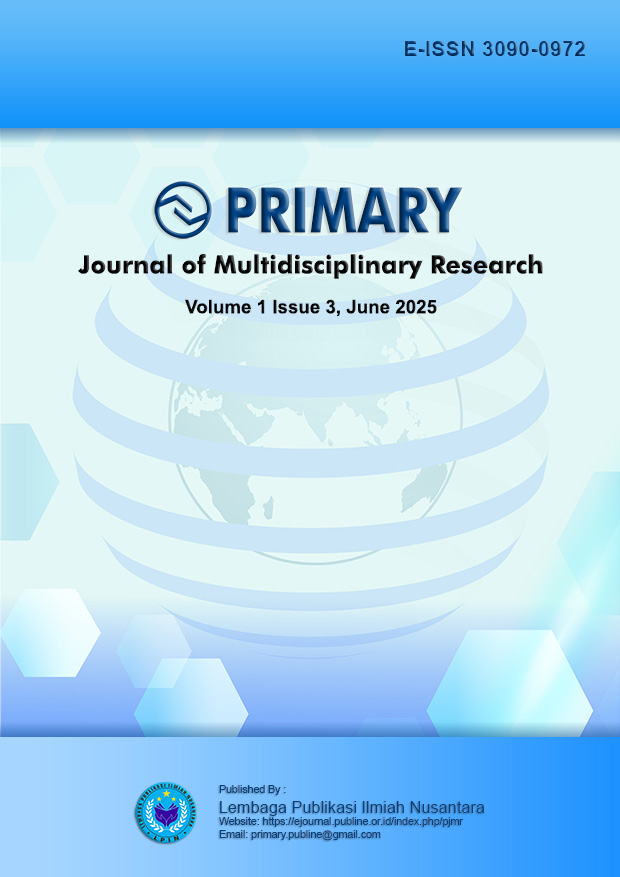Profitabilitas sebagai Mediator Pengaruh Risiko, Modal, Tata Kelola, dan Efisiensi terhadap Pertumbuhan Laba Bank
DOI:
https://doi.org/10.70716/pjmr.v1i3.202Keywords:
Credit Risk, Board Size, Return On Assets (ROA), Return On Equity (ROE_Growth), Operational Efficiency, Indonesian BanksAbstract
This study investigates the mediating role of profitability, as measured by Return on Assets (ROA), in the relationship between credit risk (Loan Loss Provision/LLP), capital adequacy (Capital Adequacy Ratio/CAR), operational efficiency (BOPO), and board size on Return on Equity (ROE) growth within Indonesia’s banking sector. The study is grounded in the growing competition in the industry and the demand for robust financial performance amidst the ongoing transformation from conventional to digital banking. The dataset comprises quarterly financial statements from 13 banks over the 2020–2024 period, yielding 260 total observations. Panel data regression and Sobel test-based mediation analysis were employed using EViews 12 software. The findings reveal that ROA significantly mediates the negative effect of LLP and BOPO on ROE growth, and positively mediates the influence of board size. Conversely, the mediating role of ROA in the relationship between CAR and ROE growth was not statistically significant. These results underscore the strategic importance of profitability in linking managerial and operational factors to the financial growth of banks. The practical implication highlights the need for banks to prioritize risk management and operational efficiency to support sustainable earnings growth.
Downloads
References
Arifin, M. D. M., & Canggih, C. (2022). Pengaruh Tingkat Kesehatan Bank Terhadap Pertumbuhan Laba Pada Bank Umum Syariah di Indonesia Tahun 2014-2020. Jurnal Masharif Al-Syariah: Jurnal Ekonomi Dan Perbankan Syariah, 7(4), 1504–1520. http://dx.doi.org/10.30651/jms.v7i4.12990
Bai, J., Choi, S. H., & Liao, Y. (2020). Standard errors for panel data models with unknown clusters. Journal of Econometrics, 218(2), 435–459. https://doi.org/10.1016/j.jeconom.2020.01.003
Baihaqi, I., & Yulianti, S. (2021). Pengaruh NPL dan ROA terhadap Pertumbuhan Laba Bank di Indonesia. Jurnal Ekonomi dan Keuangan Indonesia, 15(1), 67-80. http://jurnal.unsil.ac.id/index.php/jak
Berbagai Bank Umum Indonesia. (2024). Laporan keuangan triwulanan periode 2020–2024. Diakses dari situs resmi masing-masing bank.
Chen, Y., & Genton, M. G. (2020). Relaxing the normality assumption in regression. arXiv preprint arXiv:2008.10957. https://arxiv.org/abs/2008.10957
Indonesia Stock Exchange. (2024). Laporan keuangan emiten perbankan. https://www.idx.co.id
Lumley, T., Diehr, P., Emerson, S., & Chen, L. (2002). The importance of the normality assumption in large public health data sets. Annual Review of Public Health, 23, 151–169. https://doi.org/10.1146/annurev.publhealth.23.100901.140546
Moorcy, N. H., & Arrywibowo, I. (2020). Pengaruh Capital Adequacy Ratio (CAR), Non Performing Loan (NPL), Debt to Equity Ratio (DER), dan Loan to Asset Ratio (LAR) terhadap Return on Assets (ROA) pada Bank Umum yang Terdaftar di Bursa Efek Indonesia Periode 2014–2016. E-Jurnal Ekonomi dan Bisnis Universitas Udayana, 24(2), 1078–1083. https://ojs.unud.ac.id/index.php/EEB/article/view/259
Munteanu, I., & Ilie, C.-A. (2024). The use of ROA and ROE in study of a bank’s profitability. Ovidius University Annals, Economic Sciences Series, 21(2), 1078–1083. https://ideas.repec.org/a/ovi/oviste/vxxiy2021i2p1078-1083.html
Pelealu, I. W., & Worang, F. (2018). Analysis the effect of loan loss provision on bank profitability: Analisa dampak cadangan kerugian penurunan nilai terhadap profitabilitas bank. Jurnal EMBA, 6(4), 3278-3287.
Samosir, H., Siregar, R., & Purnama Sari, W. (2022). Effect Of Bank Soundness Level On Profit Growth Of Banking Companies Listed On IDX 2015-2019. JIKABI), 1(1), 68–79. https://doi.org/10.31289/jbi.v1i1.1062
Samosir, R., Simanjuntak, H., & Tampubolon, S. (2022). Faktor-Faktor yang Mempengaruhi Pertumbuhan Laba Bank: Studi Empiris di Indonesia. Jurnal Keuangan dan Perbankan, 26(1), 55-72.
Setiawan, A. W., Sriwidodo, U., & Wardiningsih, S. S. (2019). Analisi Kinerja Keuangan Terhadap Pertumbuhan Laba Pada Bank Umum Swasta Nasional Devisa di Bursa Efek Indonesia Tahun 2015-2017. In Jurnal Ekonomi dan Kewirausahaan (Vol. 19, Issue 3).
Sunaryo. (2020). Pengaruh CAR dan BOPO Terhadap ROA pada Bank Syariah pada Tahun 2011-2018. Perisai: Islamic Banking and Finance Journal, 3(1). https://doi.org/10.21070/perisai.v3i1.2160
Widarti, & Wulandari, N. (2022). Pengaruh Metode RGEC Terhadap Pertumbuhan Laba Pada Perbankan Milik Negara Yang Terdaftar Di Bursa Efek Indonesia. Ilmiah Ekonomi Dan Bisnis, 10(2), 969–980. https://doi.org/https://doi.org/10.37676/ekombis.v10i2
Yulianingsih, T., Listiana, E., Malini, H., Wendy., & Giriati. (2024). The Effect of Risk Profile, Profitability, and Capital on Profit Growth of Indonesian Digital Banks. Ilomata International Journal of Management.
Downloads
Published
How to Cite
Issue
Section
License
Copyright (c) 2025 Fransisco Yubileus, Anwar Azazi, Ramadania, Uray Ndaru Mustika

This work is licensed under a Creative Commons Attribution-ShareAlike 4.0 International License.











